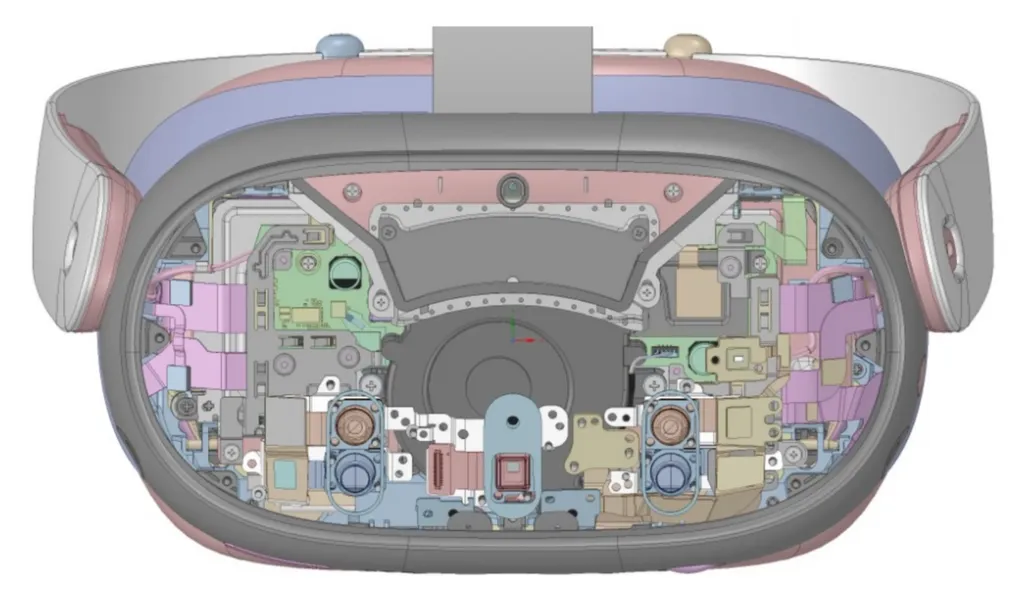Findings suggest Quest 3’s GPU will likely be at least twice as powerful as the one used in Quest 2 and Pico 4.
Meta & Qualcomm recently announced “a multi-year broad strategic agreement” to build next-generation Snapdragon XR chipsets, involving both companies’ product & engineering teams working together. Last week, apparent schematics of Quest 3 were leaked to YouTuber SadlyItsBradley (Brad Lynch), revealing key features including pancake lenses and a depth sensor. Lynch also claimed a source told him the headset will use the yet-to-be-announced Snapdragon XR2 Gen 2 chipset.
Current standalone headsets – including Quest 2, Pico 4, Vive Focus 3, and Lynx R1 – use the current XR2, which was recently retroactively labeled Gen 1 by Qualcomm. XR2 Gen 1 is a variant of the Snapdragon 865 smartphone chip that first shipped in early 2020. But Qualcomm has since followed up the 865 line with two new generations, 888 and 8 Gen 1 – the company changed the naming scheme with the release of the latest model. Given Qualcomm’s typical schedule, Snapdragon 8 Gen 2 should be announced at the Snapdragon Summit next month and ship next year.
| Chipset Series | Process | GPU Model | TFLOPS | Used In |
| Snapdragon 821 | 14nm | Adreno 530 | 0.5 | Oculus Go |
| Snapdragon 835 | 10nm | Adreno 540 | 0.6 | Oculus Quest / Vive Focus / Pico G2 / Lenovo Mirage Solo |
| Snapdragon 845 | 10nm | Adreno 630 | 0.7 | Pico Neo 2 |
| Snapdragon 855 | 7nm | Adreno 640 | 0.9 | |
| Snapdragon 865 (XR2 Gen 1) | 7nm | Adreno 650 | 1.2 | Quest 2 / Vive Focus 3 / Pico Neo 3 / Pico 4 / Lynx R1 |
| Snapdragon 888 | 5nm | Adreno 660 | 1.7 | |
| Snapdragon 8 Gen 1 | 4nm | Adreno 730 | 2.2 | |
| Snapdragon 8 Gen 2 (XR2 Gen 2) | 4nm | Adreno 740 | ??? | Quest 3? |
Qualcomm’s GPU line used in its chipsets is branded Adreno. The original Oculus Quest used the Adreno 540, with 0.6 teraflops performance. Quest 2 shipped with a three generations newer chipset featuring the Adreno 650, delivering twice the performance at 1.2 teraflops.
The more powerful GPU is used to drive Quest 2’s higher resolution and higher refresh rate display, as well as improving the graphical fidelity of VR games. Many major Quest Store titles now release only for Quest 2, as the original just isn’t powerful enough.
A finding from data miner Samulia suggests Meta plans to again deliver a similar leap in performance with Quest 3.
30-37921-2 / CCA ASSY, SXR2230P PROJECT HALLIDAY, DAUGHTERCARD BENCH 1X SKT DDR PART OF DTP QTY 1 NOS
FOC INTEGRATED CIRCUIT CP90-35514-91 / SXR2230P 000-Y1, PSP1828, 2X 4KX4K MR, 4 2 GOLD, 4XLP5, A740, 10XMONO, HTP, 3
XR2 Gen 1’s model number is SXR2130P. But Samulia found recent import logs referencing a new chip with model number SXR2230P codenamed “Project Halliday” – a likely reference to the fictional creator of the OASIS metaverse platform in Ready Player One. The change in the model number from 1 to 2 indicates this is the XR2 Gen 2 rumored to be in Quest 3.
Some of the logs include the text ‘2x 4Kx4K‘ and ’10xMONO’, suggesting the chip can power headsets with dual 4K displays and up to 10 cameras. But as noticed by SadleyItsBradley, the text also lists ‘A740’ – almost certainly referring to the Adreno 740 GPU expected to launch in Snapdragon 8 Gen 2.
The existing Adreno 730 already offers 2.2 teraflops performance, around 80% more than Quest 2’s Adreno 650. If Adreno 740 offers even a modest performance leap Quest 3’s GPU will be at least twice as powerful as Quest 2’s. This would enable higher fidelity graphics on higher resolution displays – and perhaps even entirely new games that simply wouldn’t be possible on Quest 2.
To be clear though: these import logs are indicative of early test chips being sent to headset makers, not mass production. The Information viewed a roadmap showing the next mainline Quest slated for 2023.
We reached out to Qualcomm and Meta for any comment or context they may wish to add.




























